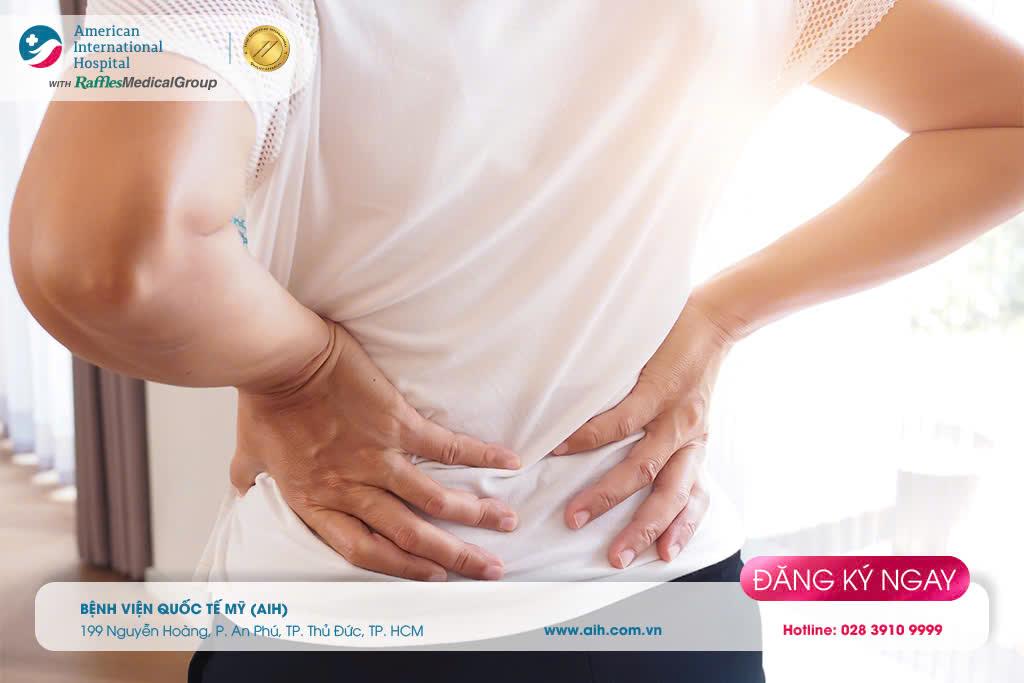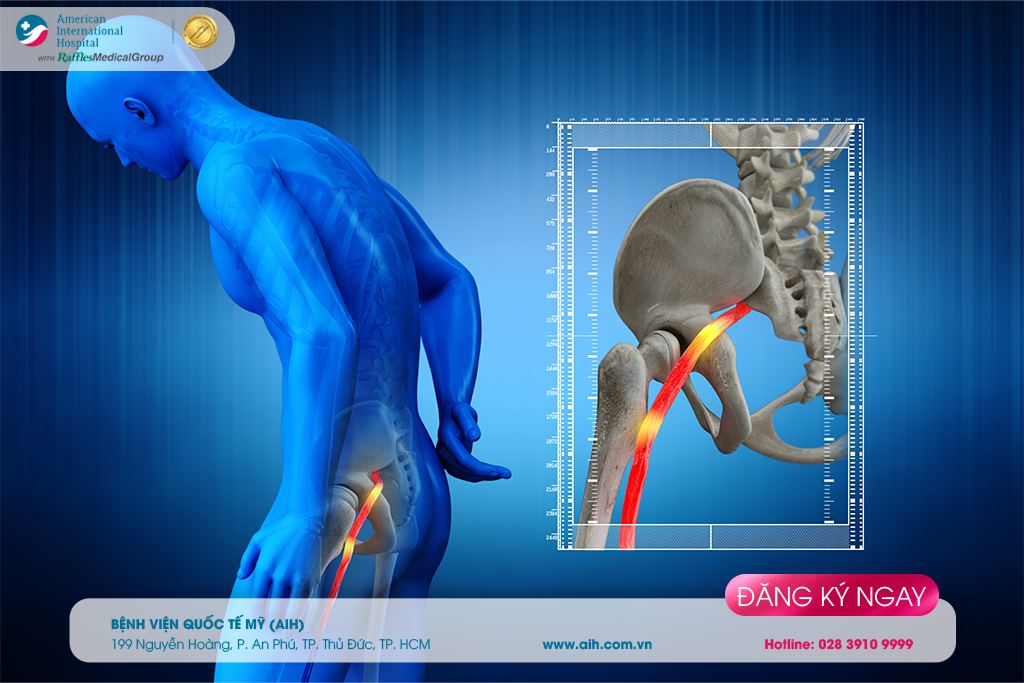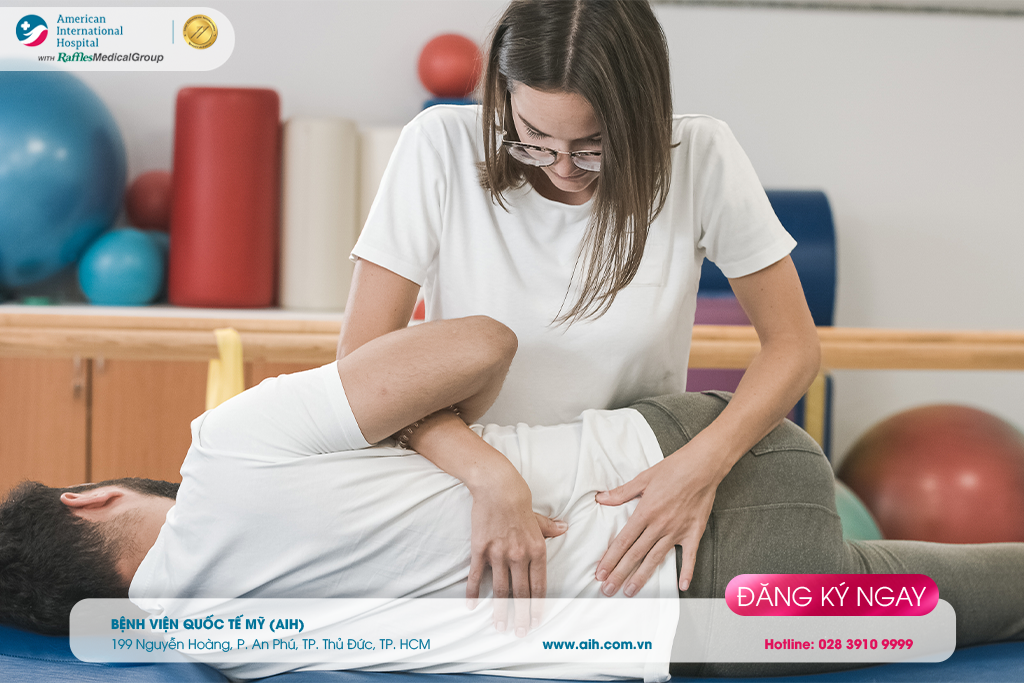Đặt lịch khám
Ngày
Chọn ngày thăm khám
Chuyên khoa
Chọn chuyên khoa bạn muốn thăm khám trong danh sách bên dưới
Bác sĩ
Hãy tham khảo thông tin từ danh sách bên dưới để chọn bác sĩ phù hợp
Giờ
Chọn thời gian thăm khám
Điện thoại
Vui lòng nhập số điện thoại di động để nhận sự hỗ trợ tốt nhất
Thông báo
Vui lòng điền vào thông tin bên dưới
*
*
*
*
*
*
Khẩn cấp
DON'T IGNORE SCIATICA PAIN
Sciatic pain results from injuries or sciatic nerve stimulation. Besides the pain, the patient can have tingling or numbness in the back or buttocks, possibly radiating down the legs. Pain often occurs in the lower back, hip, buttocks or legs and can even extend to the feet and toes, causing significant pain, and hindering movements and patients’ daily activities.
► When does sciatica pain occur?
The sciatic nerve is the longest and thickest nerve in the body with a width up to 2cm. Despite the name, it is not a single nerve but rather a bundle of nerves originating from the five nerve roots that branch off from the spinal cord.
In the human body, there are two sciatic nerves – one on each side - running along the hips, buttocks, down the legs and to the knee. Here, they split into different nerves connecting to the further parts such as the lower legs, feet and toes.
Sciatica is pain that occurs along the sciatic nerve pathway. The main reason for sciatica is herniated disc or bone overgrowth applying pressure on the spinal nerve roots.

In the human body, there are two sciatic nerves – one on each side - running along the hips, buttocks, down the legs and to the knee. Here, they split into different nerves connecting to the further parts such as the lower legs, feet and toes.
Sciatica is pain that occurs along the sciatic nerve pathway. The main reason for sciatica is herniated disc or bone overgrowth applying pressure on the spinal nerve roots.

► Individuals prone to sciatica pain
Sciatica pain is relatively common, especially among the following groups:
- Individuals who had or currently have spinal or lumbar spine injuries are prone to developing sciatica pain
- Senior citizens: the natural wear and tear of the spine over time can cause nerve compression, herniated discs or degenerative joints - main causes for sciatica
- Individuals who are overweight, obese or pregnant: increased body weight due to weight gain or pregnancy forces the back muscle to work harder which places pressure on the nerve.
- People works in specific occupation: jobs requiring heavy lifting, excessive bending, or inappropriate postures can increase the risk of having lower back problems. On the other hand, jobs involving prolonged sitting and sedentary time such as office work also increase the risk of lumbar spine issues, if proper back support is not provided.
- Sport enthusiasts: sport players, gymnasts who practice with incorrect postures are also prone to sciatica.
- Diabetes patients: type 2 diabetes increases the risk of peripheral neurological diseases, causing damage to nerves.
- Cigarette smokers: nicotine use might affect circulation and increase the risk of chronic muscle pain, including sciatica.

► Causes of sciatica pain
Sciatica pain can be a result of any condition affecting the sciatic nerves, including:
- Herniated discs
- Degenerative dics
- Spinal stenosis
- Foraminal stenosis
- Spondylolisthesis
- Osteoarthritis
- Trauma
- Pregnancy
- Tumor, cyst or other developing tumors
- Conus medullaris syndrome
- Cauda equina syndrome
► Symptoms of sciatica pain
Symptoms of sciatica pain may include:
- Pain: Sciatica pain arises from pressure on the affected nerve. Patients usually describe the sciatica pain as a burning sensation or an electric shock. This pain also runs down the affected leg. Pain often occurs with cough, sneezes, forward bending or leg rising while lying flat.
- Tingling or pins-or-needles sensation: Similar feeling to numbness after sitting with crossed legs for a long time.
- Loss of sensation: Patients lose the sensation in affected areas of the back or legs due to difficulties in signal transmitting from the back or legs to the brain.
- Muscle weakness: This is a more severe symptom - a sign of motor signals having difficulties reaching the back or legs.
- Urinary or fecal incontinence: This is an extremely severe symptom, when the controlling signals are unable to reach the bladder and bowel.

► Complications of sciatica pain
Most cases of sciatica pain due to herniated discs can fully recover after several weeks or months of treatment. However, sciatica pain can also lead to chronic pain or, if not treated promptly, permanent neural damage leading to loss of sensation in the affected leg.
If the patient suffers from severe leg pain and inability to walk, bladder or bowel complications, surgical treatment needs to be provided.
If the patient suffers from severe leg pain and inability to walk, bladder or bowel complications, surgical treatment needs to be provided.
► Diagnosing sciatica pain
In order to diagnose sciatica pain, doctors can include other physical assessments, such as:
- Walking: Sciatica pain may affect the patient's gait. Observing those changes is a part of diagnosing sciatica pain.
- Straight leg raising testing: The patient lies flat on the bed with both legs extended. The doctor will raise one leg at a time, checking the pain level or other symptoms to identify the cause.
- Strength and flexibility testing: Some other tests on strength or flexibility may be conducted to identify other factors, if any, that cause or contribute to the sciatica pain.
► Treating sciatica pain
Sciatica pain levels can vary. Therefore, type of treatment will depend on the condition, severity and causes:
1. Home treatment
Depending on the cause, mild cases of sciatica pain can improve with home treatment. These methods may include:
- Cold compress: Apply cold packs or ice covered in cloth and apply on the sensitive area in 20 minutes, repeat several times a day to aid the pain and swelling for the first few days.
- Heat compress: After using cold compress for several days, patient can switch to warm compress or warm cloth for 20 minutes at a time. The patient can choose either a warm or cold compress depending on its effectiveness.
- Over-the-counter drugs: Nonsteroidal anti-inflammatory drugs (NSAIDs) can help reduce pain, swelling, and inflammation. However, misuse or prolonged use may lead to unwanted side effects.
- Stretching and movement: Gentle exercises like stretching the back muscles, strengthening exercises, or low-impact aerobics activities can help relieve sciatica pain.
If symptoms do not improve after a few weeks, patients should seek medical advice for appropriate treatment.
Note that these methods are for mild pain only; moderate to severe pain, numbness, tingling, or muscle weakness should be evaluated by a doctor immediately rather than treated at home.
2. Conservative treatments
Conservative treatments may include:
- Prescription medication: Pain relievers, muscle relaxants, and other medications like tricyclic antidepressants or anticonvulsants may help alleviate sciatica pain, especially with chronic pain or nerve-related symptoms.
- Physical therapy: Physical therapy aims to reduce sciatica pain by alleviating pressure on the nerve. Patients might be guided to do stretching or low-impact exercises such as walking, swimming, or water aerobics.
- Spinal injections: Corticosteroid injections may provide temporary relief for up to three months. Doctors will advise patients on their suitability for such treatments.
- Alternative therapies: chiropractic adjustments, yoga, acupuncture, or massage,…
3. Surgical treatments
Surgery is considered a last resort when sciatica pain is severe and conservative treatments fail. Surgery is typically recommended only if there are warning signs of nerve damage or if pain significantly impairs daily work and life and does not improve after 6–8 weeks of conservative treatment.
Surgical options for sciatica pain include:
- Discectomy: Depending on the severity, doctors may remove fragments of the herniated disc, partial or entire disc pressing on the nerve.
- Laminectomy: Removal of part of the lamina, the rear portion of the vertebra, to relieve pressure on spinal nerves.

► Preventing sciatica pain
The following measures can help prevent sciatica or reduce its risk:
- Maintain proper posture: Practice correct posture techniques when sitting, standing, lifting objects, and sleeping.
- Quit smoking: Nicotine, from all sources (including e-cigarettes), reduces blood flow to the bones, weakening the spine and its components.
- Adopt a healthy lifestyle: Ensure a nutritious diet, ensure sufficient amount of calcium and vitamin D to maintain bone health.
- Build physical strength: Regular exercises of muscle strengthening and flexibility train such as stretching, walking, aerobics, yoga, and swimming can strengthen core muscles and improve back health.
- Avoid falls: Avoid unnecessary high heels, wear slip-resistant shoes, and maintain a clean and well-lit living space to reduce fall risks.
- Allow time for recovery: Avoid heavy work during back pain episodes to prevent more severe injury. Rest, engage in gentle movements, and practice appropriate exercises to give the body time to heal.
--------------------
For checkup and consultation at AIH:
☎️ Hotline: (028) 3910 9999
🌏 Website: www.aih.com.vn
📍 Address: (Entrance from 199 Nguyen Hoang Street) No.6, Bac Nam 3 Street, An Phu Ward, Thu Duc City, Ho Chi Minh City.






































































Để lại bình luận